#about : ceridwen
Explore tagged Tumblr posts
Note
👰♀️ Ceri?
Ceri and Jack get married a lot so this is just one of many but also my favourite

2 notes
·
View notes
Note
Does Ceridwen ever interact with Neloth? Or our favorite Dunmer mercenary Teldryn? I'd imagine Solstheim would be ripe with opportunity to practice her destruction magic and necromancy since Morrowind doesn't have the same cultural restriction on such activities.
She does interact with Neloth for a bit after the CoW. Her boyfriend Ralos a looking for a Telvanni Master to apprentice under and he mentions that Neloth is in Solstheim who would be the closest; but that her father had suggested he find someone else because Neloth is “insufferable”.
Ceri says her father thinks that about a lot of people 😛 And is able to encourage him to go and try as she would also like to visit as that where her brother was born and her mother still owns property in Raven Rock.
And she does meet Teldryn, he is more of “Uncle Tel” as him and Theodora stayed in contact after she left. When Arthano gets older and wants to start learning to use a sword, Theo is too busy to teach him herself so she writes to ask Teldryn if he’d be interested in a safer job 😛
Gets to meet Ricardo and Ceri, as well as complain about the Empire in their capital. He’s with them for 2 years in the city.
But back to Neloth haha, upon meeting him she gets what her father meant and she doesn’t like how Ralos is treated. He becomes more of an errand boy but says he’s learning a lot. He stays in Tel Mithryn where as Ceridwen is mostly in Raven Rock. After an attempt on his life in which she saves him, Neloth starts training Ceri too and it’s then where he learns he’s met her parents 😅
She ends up quite liking Morrowind and wants Ralos to take her to the mainland someday. Great place to hone her destruction skills. Also she’s not a necromancer, originally thought she wanted to study Alteration but enjoyed Destruction more.
8 notes
·
View notes
Text
oh Solas Hates hates when you're Dalish and proud of it lmao
#Ceridwen: yeah I'm from a Dalish clan and like my people#Solas: oh that's disappointing#motherfucker- he's so mad about the elves struggling to survive huh#my babygirl is trying to learn more about the world and other people homie#but she still loves her people?? this egg is so weird#esp considering I know who he actually is lmao#DAI Posting
3 notes
·
View notes
Text
x. background & interactions
Nuala - name meaning “fair shoulder” or “fair-shouldered one” Cerridwen - name meaning “fair” or “blessed poetry”; mythological enchantress & goddess of the Underworld Allegiance: Velaris & The Night Court - Though Nuala & Cerridewen attend Feyre and later Elain as handmaidens or attendants, this is often a cover job title that is used to explain their accompaniment to the Inner Circle & High Lord & High Lady. Though their friendship and allegiance to both Archeron sisters keep them in these services when not directly working under their actual title as spies for Azriel or Rhys, they do ultimately serve and answer to them in all capacities. Ultimately, I think they serve Azriel first and foremost (take that as good or bad?) but abide by his loyalty to Rhys and subsequently align themselves with the High Lord. - Nesta and the power they sense from her feels foreign and not quite right, making both of the twins very uncomfortable around her and in her presence. They prefer to maintain their distance from her unless directly ordered to do so otherwise as she feels like unstable and untapped magic they are incredibly perceptive to. Due to their protectiveness of both Feyre and Elain especially, this compounds how they feel about the eldest Archeron and often the treatment of them they’ve witnessed (knowingly or unknowingly).
#✲ NUALA [ headcanon ]#✲ CERRIDWEN [ headcanon ]#✲ NUALA [ about ]#✲ CERRIDWEN [ about ]#✲ NUALA [ dynamic ] CERIDWEN#✲ CERRIDWEN [ dynamic ] NUALA#✲ NUALA [ dynamic ] FEYRE ARCHERON#✲ NUALA [ dynamic ] ELAIN ARCHERON#✲ NUALA [ dynamic ] NESTA ARCHERON#✲ NUALA [ dynamic ] AZRIEL#✲ NUALA [ dynamic ] RHYSAND#✲ CERRIDWEN [ dynamic ] FEYRE ARCHERON#✲ CERRIDWEN [ dynamic ] ELAIN ARCHERON#✲ CERRIDWEN [ dynamic ] NESTA ARCHERON#✲ CERRIDWEN [ dynamic ] AZRIEL#✲ CERRIDWEN [ dynamic ] RHYSAND#picking up 2 muses means so many tags jfc
3 notes
·
View notes
Text
》 Birthday Card Series: February Edition 《


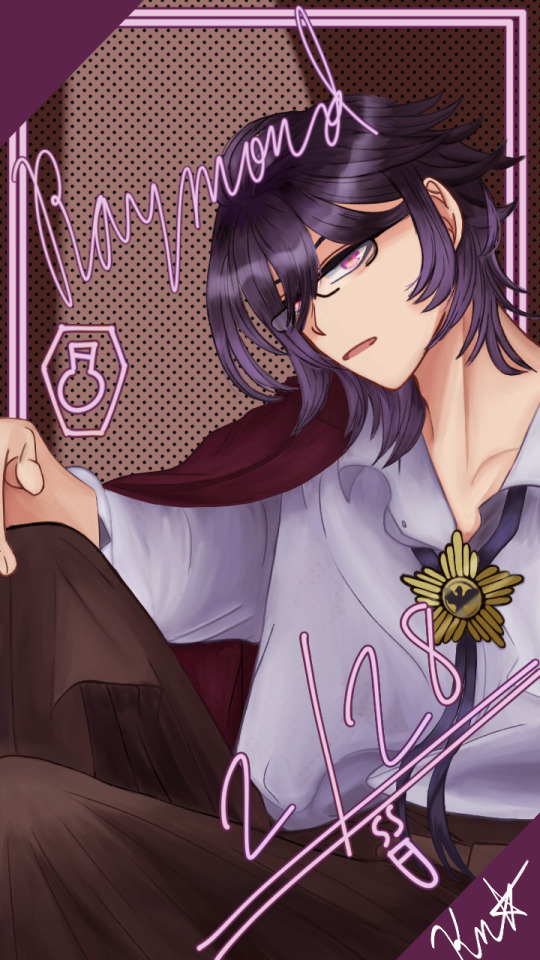
"Thank you very much for everyone's greetings, I wish we could celebrate my birthday in my hometown since birthdays there are festive, but I'm happy that everyone tries their best to make me happy in NRC."
- Evelyn Ceridwen
"Say, since it's my birthday, why don't we fly through the twilight sky and drink latte on our ride~? That's a bad idea? A little magic would solve the problem!"
- Rosetta Esprimere
"I don't like birthday parties, they're a bit too loud and messy for my liking. I'd prefer it if it was going out to eat at a 5-star buffet. What? You bought tickets for an amusement park? Ahem- I'll consider your invitation- Hey I did not protest any amusement park birthday celebration!!!"
- Raymond Karloff
========================
I managed to draw Evelyn's and Rosetta's birthdays before their birthdays but I ended up forgetting Raymond's 👹. College was preoccupying me grrr but alas I did the February batch and now onto the March batch which is ANOTHER 3 OCS.
For context of who they're TWST off for those who are curious:
Evelyn Ceridwen - Is not twst off of anyone, an original OC from my worldbuilding and the Yuu of the story
Rosetta Esprimere - Twst off of Latte Cookie from Cookie Run Kingdom
Raymond Karloff - Twst off of Reiji Sakamaki from Diabolik Lovers
#twisted wonderland#twst#auniro's art#twisted wonderland oc#twst oc#evelyn ceridwen#rosetta esprimere#raymond karloff#atp this is just my art blog and not a ramble blog about my ocs ehue#im still posting on twitter but only the good ones
3 notes
·
View notes
Text
slowly but surely losing my shit over here this is fine everything is fine everyone around me makes good decisions all the time and never endanger the rest of the party
0 notes
Text

☼☾ ( AJ COOK , 45 / AROUND 1300 , SHE/HER , CISFEMALE , NIXIE, QUEEN ) - have you seen CERIDWEN FFLUR CEFNFOR? they’ve been living in afon vale for OVER 1000 YEARS and they really think they’re safe. people say that they’re DECISIVE but i heard they’re EVASIVE. you can usually find them working as a NIXIE QUEEN at AFON VALE NIXIE COURT. they’ve tried hard to keep THEIR DESIRE TO CLAIM OWNERSHIP OF AFON VALE buried but the truth always comes out. a few things that remind me of them are … crystallised salt speckled through golden hair, a smile reserved for victory, benevolence that cannot be mistaken for tolerance, a hunger for a life unlived.
basics
full name : ceridwen fflur cefnfor
name meaning: poetry / song, white / fair, flower, ocean
nickname / alias: your majesty ( to her subjects ), ceri ( to her first consort )
gender / pronouns: she/her
sexuality: pansexual
age, birthday + star sign: 45/around 1300, 17th august + leo
place of birth: afon vale, wales
accent : south welsh
occupation: queen
associated locations: glydŵr cove
song: you should see me in a crown by billie eilish
appearance
faceclaim: aj cook
height: 5"9
eyecolor: pale blue
haircolor: golden blonde
build: willowy
tattoos / scars / key features: royal sigil at the base of her neck acquired when she became queen
personality
positive traits: decisive, resilient, diplomatic
negative traits: evasive, calculating, reticent
relationships
parents : queen catrin alys cefnfor ( mother, deceased ), alwyn bowen ( father )
siblings : angharad cefnfor ( younger sister ), bethan cefnfor ( younger sister ), ffion cefnfor ( younger sister ), heledd ( younger sister ), carwyn ( younger brother ), gruffudd ( younger brother ), owain ( younger brother ), steffan ( younger brother )
children : guinevere cefnfor ( eldest daughter ), middle cefnfor ( middle daughter ), arwen cefnfor ( youngest daughter )
pets : rhyfelwr ( fin whale )
other
species: nixie
characters she’s inspired by:
history
born a princess to the royal nixie court over 1300 years ago, ceridwen remembers very little of her childhood and what she does remember she represses. her mother queen catrin was a cold and cruel woman that ruled her kingdom without mercy. ceridwen was one of countless heirs her mother sired but as the first born, she bore the brunt of her mother's expectations. she had to be perfect, be the ideal, and was groomed to be a ruler from the day she was born.
her mother, the former queen, met a grisly end when ceridwen was only 300. assassinated under the instruction of a foreign court as revenge for failing to marry off her eldest to their own heir. inheriting the throne and the rivalry, ceridwen was quick to put an end to the problem by drawing in the support of other courts. where her mother had been an easy enemy, ceridwen was optimistic and diplomatic.
ceridwen promised herself from an early age that she would not rule like her mother had. that she would love her people, and show them warmth and kindness. but time is long, waters cold, and a naive heart is easily hardened - more and more ceridwen finds herself mirroring the monster she wished to avoid becoming.
as queen, it was a responsibility of hers to continue the family line should something befall her. as such she felt a vast pressure to have children but did not want to have countless, unloved heirs like her mother did. but ceridwen did not have an easy time getting pregnant, much to her buried grief she lost several children to miscarriage and stillbirth. her three successful children are the only thing she professes to love; though she reserves her affections for behind closed doors.
she has never married and doesn't believe romantic love is logical. her three consorts were chosen for their strong bloodlines, loyalty to the crown, and expectation to produce heirs. while she cares, in her own way, about each of her consorts - she has a different dynamic with each of them. her first consort is the only one she truly loves, though she would deny it. and if the choice was demanded of her, she would always put her kingdom first and he knows that.
the decision to emerge from the underwater court and position themselves in afon vale was hers and it is the first step in a long game she has been playing. for the moment, ceridwen is ascertaining which species can be trusted and which are worthy of allegiance. but she does aspire to one day claim afon vale for the cefnfor monarchy.
0 notes
Text
Writing Reference: 5 Symbols
for your next poem/story (pt. 3)
CAULDRON

In understanding symbols, sometimes it is useful to simply look at the shape and see what it resembles.
The traditional cauldron represents nothing so much as the belly of a pregnant woman and, unsurprisingly, it is an important female symbol all over the world.
The circular shape of the cauldron gives another clue; the circle is a symbol of never-ending life and regeneration, and these themes recur repeatedly in stories containing cauldron symbolism.
The way the cauldron is used also gives a hint about its symbolic meaning.
Things are put into the cauldron, heated, and something different is taken out; the basic ingredients are transformed.
Therefore, the cauldron also symbolizes germination and transformation.
Traditionally, cauldrons have three legs:
The number 3 in this instance represents the triple aspect of the Great Goddess, or the three fates.
Shakespeare alludes to this when the three Weird Sisters—arguably the most famous witches in literature—cook up trouble at the beginning of Macbeth.
In pre-Christian literature, countless legends feature magical cauldrons, and it may be because of this that the cauldron has its witchy associations.
Celtic tales tell of cauldrons that contain an unending supply of food or of knowledge.
The dead are frequently thrown into a magical Cauldron of Rebirth and climb out the next day, alive once more.
Mythical warriors and heroes who died in battle are restored to life in this way.
Ceridwen (one of the most powerful witches in all of Celtic mythology and is typically depicted as simultaneously a mother and a wise woman) had a cauldron full of inspiration and magical powers.
In India, a magic life-giving food, called Soma, was brewed in three huge bottomless cauldrons.
In Greece, there are tales in which an ordeal of initiation involves the person boiling in a cauldron, but after the rite, the initiate emerges with magical powers, including the gift of immortality.
CHNOUBIS

The Chnoubis is a hybrid creature, with the head of a lion and the tail of a serpent.
It was carved onto stones for use as an amulet, providing protection against poisons in particular.
Amulets featuring the Chnoubis date back to the first century and it is supposed that this odd-looking creature may be related to Abraxas, whose image was used in a similar way.
CLADDAGH

The Claddagh is a popular symbol, often incorporated into the design of rings.
Traditionally used as a wedding ring, it is so-called because it was originally made in a Galway fishing village of the same name in 17th century Ireland.
However, the elements of the design are much older, stretching back into pre-Christian Celtic history.
The Romans had a popular ring design, the Fede, which featured clasped hands.
“Fede” means “fidelity.”
The Claddagh symbol features a heart held by a pair of hands.
A crown usually surmounts the heart.
These features represent love, friendship, and loyalty.
CORNUCOPIA

Also called the Horn of Plenty, the cornucopia is often depicted in paintings and on friezes where it symbolizes the notion of boundless abundance, as flowers, fruits, sheaves of wheat, and other produce spill out of a hollow horn or a twisting basket woven in the shape of the horn.
The origin of the cornucopia is found in the Greek myth of Amalthea.
Amalthea fed the infant Zeus a drink of goat’s milk and was given the brimming goat’s horn as a reward.
Sometimes the infant Zeus is depicted being fed the milk from the horn itself.
The Cornucopia, as a symbol of a bounteous harvest, is also associated with Ceres, the Goddess of corn, and also with Fortuna, Goddess of good fortune.
CROSSROADS

In fairy stories and myths, it is often at the crossroads where mischief awaits, usually in the form of other-worldly spirits.
Effectively, the crossroads symbolizes the intersection of two paths, making four potential routes, and a place where a decision must be made, not only practically, but metaphorically too.
The X of the crossroads marks a spot where two worlds meet.
The origins of this story go back to African folklore, where a deity called Esu was the guardian of the crossroads.
When Christianity took over, these old Gods were, quite literally, demonized, and Esu was transformed into the Devil.
Hecate, too, personified as the Queen of the Witches, was called the Goddess of the Crossroads.
In Celtic mythology, corpses belonging to those considered “unholy” were buried at crossroads in order to prevent them coming back to life and because the crossroads was a Gate to the Otherworld. Gibbets were placed at crossroads for the same reason.
Source ⚜ More: On Symbols ⚜ Writing Notes & References
#writing reference#symbolism#symbols#writeblr#halloween#spilled ink#dark academia#witchblr#literature#writers on tumblr#writing prompt#poetry#poets on tumblr#writing inspiration#creative writing#light academia#writing inspo#writing ideas#mythology#folklore#writing resources
60 notes
·
View notes
Text

Hey tumblers ive gone slightly mad
Anyways um yeah heres my son Variumn being struck by lightning as he flees from the clan after being chased out in an attempt to protect Indaviing from Ceridwen. took about 12 hours? Idk
#flightrising#flightrising art#frfanart#flight rising#fr art#fr artist#fr fanart#dragon art#art#artists on tumblr#fr imperial#imperial fr#Lightning
69 notes
·
View notes
Text
okok more headcanons- I have more for some Harbingers than others, I'll do Dottore and Crucy in this one. I have a lot of angsty ones about Crucabena in particular, but I'll just do some fun ones here so it won't get to heavy (same with Scara later on) Dottore: -most people can't really get under his skin. He used to be a lot easier to anger (see Webtorre), but Prime and the older segments have gotten good at keeping it disguised. A notable exception to this rule is Scara, mainly because of their complicated relationship- like Nahida explained, he is jealous of him, and this too manifests in his (lack of) patience when interacting with Scara compared to others. -not all that concerned about people he's close to dying. Has a vast amount of forbidden knowledge, so he knows about Teyvat running in a sort of loop. He's annoyed when people he's close to die, yes, but he knows they'll come back in some form in the next cycle, so he's kind of detached. -Doesnt actually have strong feelings about (new) Arlecchino. He's annoyed that he has less test subjects now, yes, and he would rather have Crucabena back, but he doesnt hate her or anything. She's an annoyance at most, but not really a threat. -does not actually like Pierro one bit (and thats mutual between the two). He's glad for the opportunities the Fatui provide, but Pierro? No. -Would collect pokemon cards. - I have a lot about Scara & him but I think I'll need a separate post for that Crucabena: -I mentioned this in the last post, but I absolutely think she was a really, really feral child. Whenever I draw her as a kid, my immediate thought is "this kid bites". -I think she was born with one of her elements (hydro/cryo). We dont see her having a vision, and I dont think she'd have two delusions. She's based off of a goddess/witch, and I think the latter describes what I see her as in Genshin. I also think she is one of the Fatui members who does not age regularly, although that's mostly my Crucattore childhood friends agenda speaking. -terrible at cooking. horrible. the house of the hearth lives off of fast food -*huge* enabler. Not just for Dottore, but for everyone that is not her children. Put her on a mission with Sandrone and find them coming back to Snezhnaya with a suspicious amount of robot-parts and new puppets. Put her and Signora into a casino and see Signora's yearly savings gone in one evening. She seems well adjusted, but she's really, REALLY not -this is more lore heavy, but I think she's related to one of the tribes Remuria conquered. Remuria ofc being based off of Rome, and her name being a romanised version of a welsh name. Frankly, I think her true name is still the welsh version and she just goes by the romanised one for *some* plausible deniability. (Similarly, Clervie is also the romanised version, although I'd say Clervie herself doesnt know) -Also her child sacrificing ideology has me thinking Enkanomiya, so I'll probably incorporate that in my AUs somehow -Was active in Fontainian politics. Because someone had to be, and it surely wasnt Sandrone. -oracle/prophet. No I will not elaborate. -Despises being called nicknames, but Dottore and Columbina (at the very least) almost exclusively address her that way. Crucabena/Ceridwen? Thats Crucy and Ceri to Dottore and Bina. -the fairytale book she reads to the children is some genuinely important semi-historical account, like a lot of the books we find in genshin are. She's aware, but she really does not care if the children figure it out. They'll die anyways. Pierro wasnt happy about it tho. -Got a lot of condolence-cards from fontainian and snezhnayan politicans after Clervie died. Genuinely took a few minutes to realise what those were about, because she really did not see it as that significant of an event. -Similarly, used Clervies death as an excuse to get out of doing her job. You want her to do paperwork?? Her, the poor woman mourning her only childs death?? Preposterous.
29 notes
·
View notes
Text
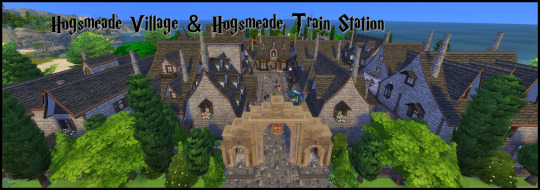


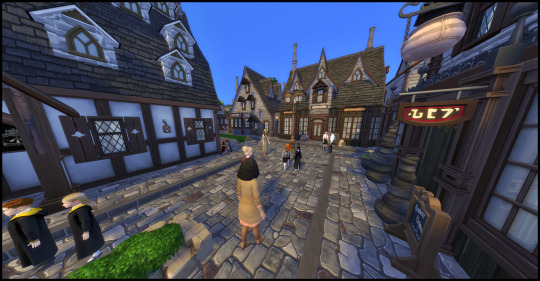



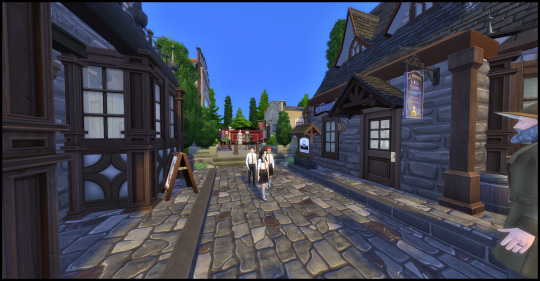
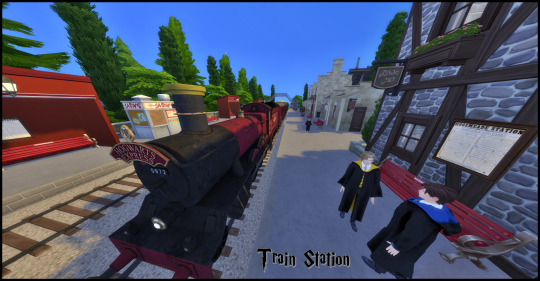
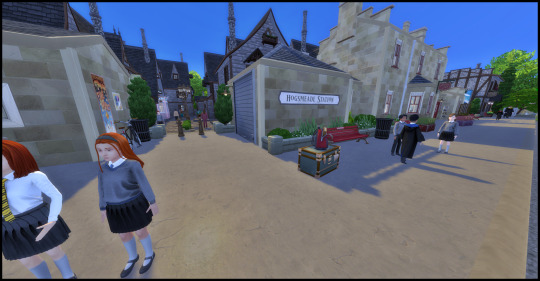
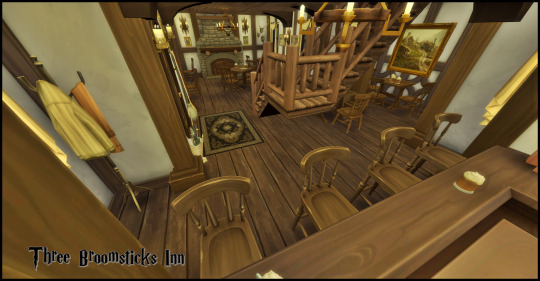
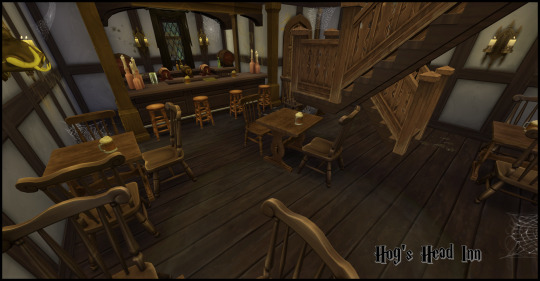
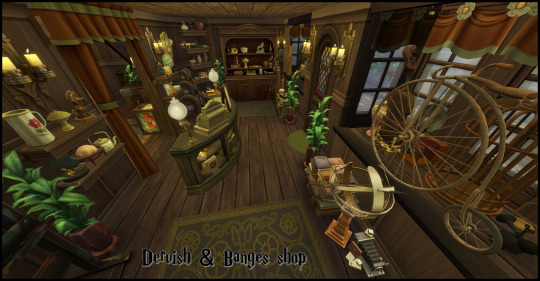
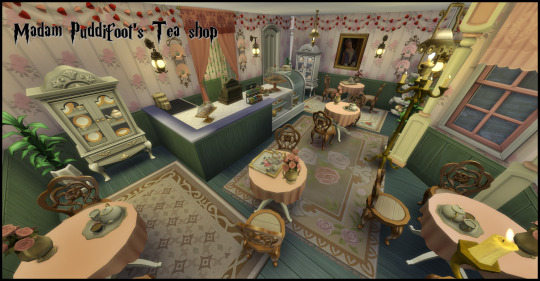
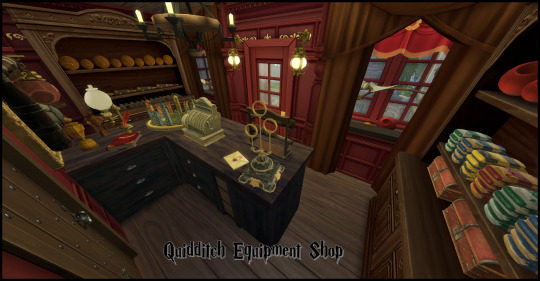
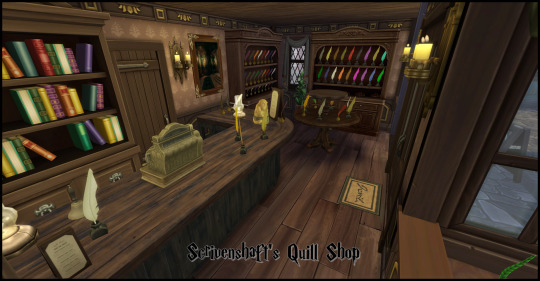
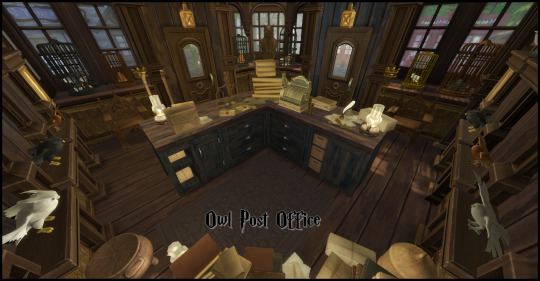
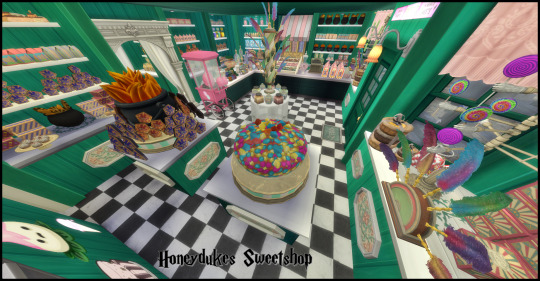
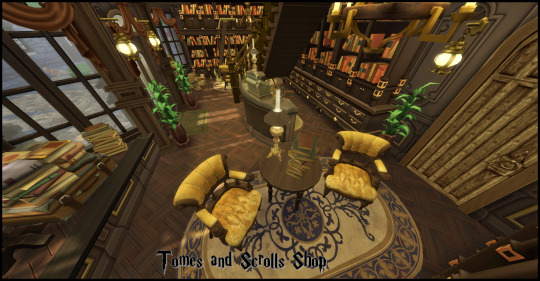
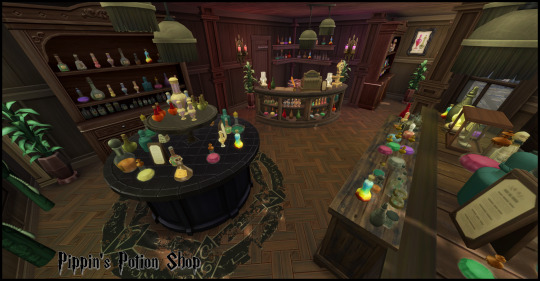
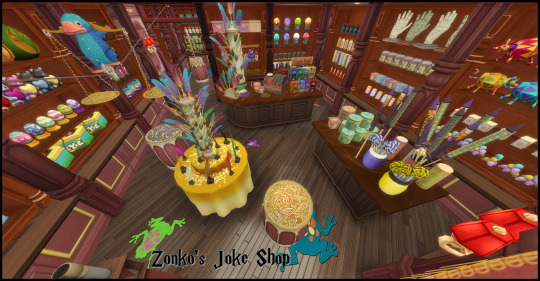

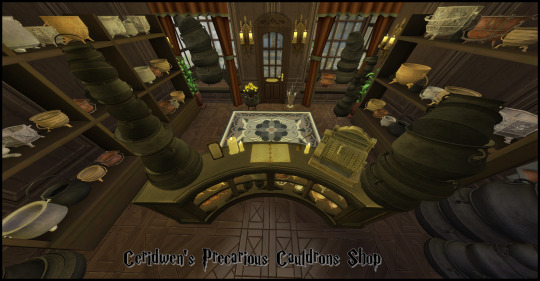
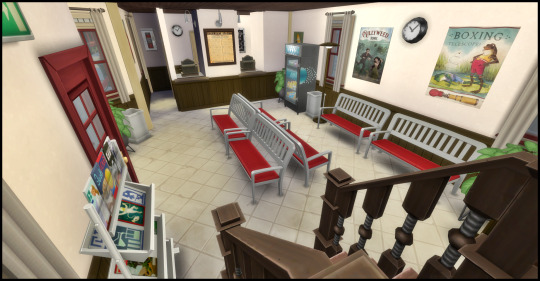
⭐️ ⭐️ ⭐️ ⭐️ Hello everyone! 🤩🤩 ⭐️ ⭐️ ⭐️ ⭐️
⚜️ I am happy to represent again my old project, that was renovated again, for final time. It’s Hogsmeade village and train station.
⚜️ These are very detailed projects and fully furnished with a lot CC, most of CC are converted by me, but there are other CC that I used from other creators. It’s mostly based on movies and games but I wanted to put there every room what I find on Hogwarts locations wiki, some are decorated by my taste.
⚜️ When sims visit this lot, they can find: a lot shops/buildings (Three Broomsticks, Dervish and Banges, Gladrags Wizardwear, Hog’s Head Inn, Honeydukes Sweetshop, Ceridwen's Precarious Cauldrons Shop, Madam Puddifoot’s Tea Shop, Owl Post Office, Scrivenshaft’s Quill Shop, Zonko’s Joke Shop, Pippin's Potion Shop, Tomes and Scrolls Shop, Quidditch Equipment Shop, Hogsmeade Train station with Hogwarts Express train), all rooms are fully furnished.
⚜️ Most of CC are by me, but I used CC from other creators, I would like to thank you to : Sifix, Severinka, Remysa, LittleDica, Pufferhead, Belkasof, JPCope, TheJim07, icemunmun.
⚜️ Here is link for download: https://www.mediafire.com/file/ack9qcsk9uubsat/Hogsmeade+by+JH.zip/file
⚜️ About my CC and this projects : feel to free use it and recolor but please do not re-upload or claim as your own, but mention credits! 😊
⭐️ ⭐️ ⭐️ ⭐️ ⭐️ ⭐️ ⭐️ ⭐️ ⭐️ ⭐️ ⭐️ ⭐️ ⭐️ ⭐️ ⭐️ ⭐️ ⭐️
#the sims#harry potter#the sims 4#hogwarts#ts4#the sims 4 harry potter#hogwarts mystery#ts#hogwarts legacy#hogsmeade
28 notes
·
View notes
Note
👗 + Ceri in The Doctors Dances?

2 notes
·
View notes
Text
WIP Wednesday
Hello everyone, happy Wednesday <3 This will be my last wip until two weeks time due to the holiday so we'll get back to normal Jan 1st. Starting the new year off right :)
Thank you for the tag @hircines-hunter <3
Tagging: @bougainvillea-and-saltwater @theoneandonlysemla @dirty-bosmer @thequeenofthewinter @pocket-vvardvark
@firefly-factory @changelingsandothernonsense @ladytanithia @lucien-lachance @scholarlyhermit @captain-of-silvenar
Theodora's children have taken over my brain and I got this silly idea of Arthano visiting Ceri at the CoW while she is working under Faralda in Destruction. Though she notices he's acting odd, not like himself... he's so real for this love older women under the cut because long EDIT: He has blood on him from fighting a bear earlier he's fine don't worry about him
Whilst they are chatting in the main courtyard, her explaining the three different towers and what they contained, her mentor approaches them.
“Hello Professor Faralda, how are you this afternoon?” There’s a notable change in her brother’s, suddenly standing taller as he removes the bloodied gloves, holding them behind his back as though he were hiding them.
“I’m quite well, Ceridwen.” A soft smile towards her before turning to him. “Ah, you must be Arthano, your sister mentioned her brother would be visiting.”
“Yes, I am Ceridwen’s brother, pleasure to meet you Professor Faralda.” Ceridwen? Ata and Ricardo called that, Mother only doing so in formal settings; her eldest sibling never used her full name. Only ever Ceri. It felt foreign hearing it in his voice, saying it casually like it was the norm for them. Now that she thinks more on it, everything he said sounded unlike him. Far too formal to come naturally from the lovable but brash man she knew him to be. Here he was using the type of speech they made fun of others for, especially their brother. Even on serious occasions, he had a habit of making jokes out of anything and everything; now very polite.
“I’ve been told you are a mage yourself, a conjurer specifically.” Gesturing with his hand, the older continues with his odd speech, adding mannerism to the mixture as well.
“Yes, I mostly work with bound weapons but I’ve dabbled a bit in Destruction myself. Nowhere near Ceridwen but not inexperienced.” Dabbled? Is that what he calls it?
“What spells in particular? Electromacy like your sister?”
“I mostly stay in the realm of pyromancy.” Repeated use of the Flames spell because he coulded be bothered to learn more is not exactly what she would refer to as pyromancy; Arthano was always one to stretch the truth. Faralda extends a similar smile to him now.
“Hmm,, very interesting, I assume you’ll be accompanying Ceridwen to dinner this evening?”
“Naturally of course.”
“Well, perhaps we all can discuss further then, I have some work to attend to now.” Turning to leave, the instructor makes one final comment. “Arthano?”
“Yes Faralda?” Such a stupid grin wipes over his face. What is going on with him?
“You are very much as your sister described you. Though I’d wash the blood off before dinner.”
“Yes Ma’am.”
Still caught up in how abnormal he’s being, it’s not until he opens his mouth again does she draw a conclusion. Fixing his posture, uncharacteristically proper tone, inflating his Destruction skills as if they were No.
“Hmm, so you’ve mentioned me?” His eyes still watching Faralda leave she seizes the opportunity while he’s distracted. Ripping one of the gloves out of his hand, she whacks him with it.
“No, no, no!”
“What the fuck? I haven't done anything!” At last he is sounding like himself again. One more smack in the shoulder as she disregards what he is saying. “Help help, I’m being assaulted!”
“I’m sorry I don’t want my brother trying to get with my advisor!”
“I’m not trying to do anything, Ceri. Just introducing myself, I don’t know if you’ve heard but that is the polite thing to do when meeting someone for the first time.” Another smack as she throws the glove this time, letting him retrieve it from the snow.
“Like I believe that,” In an attempt to mimic his voice she utters his own words back at him “I’ve also dabbled a bit in Destruction myself, please.” As he stands up, dawning the bloodied gloves once again. “It’s gross.” A smirk almost as stupid as his grin prior appears.
“Well Ceri, that’s not nice to say about your professor. Respect your elders, she seems far from gross.”
Ugh her brother strived to find the balance between charming and insufferable, something he was normally good at. Being naturally social had its benefits. Everyone could appreciate a good joke and if they couldn’t, well then he had no reason to bother with them further. Now however, knowing he had an interest in her mentor, the woman who had graciously taken her under her wing, makes her more annoyed than anything.
“You, you’re gross.” Briefly, her hands flex, forgetting she has already thrown the glove at him. “And she’s too old for you.”
“Oh I wouldn’t say that, how old is she?” Brow raised in curiosity, the younger answers him before it occurs to he should not be given such details.
“She’s one-hundred twenty something, don’t remember exactly.”
“Oh we’re fine, less than a century apart. Barely noticeable even.” The gap between her and Ralos was barely noticeable, two years; Ninety-odd years was definitely something to take note of. But unfortunately this checked out for her brother, perhaps she can introduce him to someone else, maybe the bard at The Frozen Hearth. He had long, shiny, blonde hair. Very within his type.
“That’s a pretty large gap, Arthano.” He shrugs.
“Well, Mother and Ata are what? One-hundred? One-hundred ten years apart? I’m doing well comparatively.” She stutters, trying to find the right words to shut him up, he is however, too quick for her. “Why is she a war criminal?”
“What? No, absolutely not.” The College was a neutral organization, both faculty and students coming from across Tamriel for the purposes of advancing magical study. Conflicts were left at the gates, to imply anything different was a lie. But he’s not implying anything about the College, rather making a further comparison to their parents.
"So I'm actually doing great."
“I should lock you in my dorm tonight and let you starve.”
#wip wednesday#oc: ceridwen#oc: arthano#ceri smacking him :P#can't blame a guy for trying#he likes pretty boys but there are not many in skyrim#so sad#well at least we have older women <3#ceri i won't let him embarrass you don't worry
33 notes
·
View notes
Text
𝔗𝔥𝔢 𝔒𝔲𝔱𝔰𝔦𝔡𝔢𝔯𝔰: ℑ𝔫𝔱𝔯𝔬𝔡𝔲𝔠𝔱𝔦𝔬𝔫
My first Curse of Strahd Group. All different in their plight, but the same in their loneliness. Who are they, and what has drawn them into the silver mists of Barovia?

𝔍𝔢𝔯𝔦𝔪𝔞𝔢:
A Nobel Fighter. Jerimae was born of his fathers affair, and has lived in the shadow of that transgression his whole life. Despite this, him and his father are very close, so it is quite distressing to Jerimae when he falls ill very suddenly. He is a fair, just, and Chivalrous man. One evening, he receives a letter from a mysterious Count that promises to help his ailing father, should Jerimae only make haste to his castle…
~

𝔙𝔢𝔰𝔱𝔞:
A Tiefling Druid. Vesta has lived amongst the Circle of the Shepherd, adopted as a babe to the Archdruid of her colony. A year ago, her mother was slain in battle, and the others in her colony distanced themselves, fearing her infernal nature. Her only friend is Ceridwen, a Grizzly who has protected her since birth. She has a prickly demeanor, but warms to anyone who looks past her devil’s horns. A white raven had brought her a mysterious letter, sent posthumously by her fallen mother, It beckons Vesta to Barovia, to finally understand the truth of her nature.
~

ℭ𝔞𝔭𝔬:
A wandering half-elf bard. They have spent their life in the road, bouncing from city to city to make a little coin off their musical prowess. The grew up up in an orphanage, spending the greater part of their youth fantasizing about the could-have-beens. The fear of abandonment has kept them from forming bonds with new people. They receive a job offer by a woman representing the Blood in the Vine Tavern, who put a lot of gold down to bring Capo in as an act for their struggling business.
~.

𝔅𝔬𝔯𝔱:
A barbarian deep gnome. Bort has been tasked by the Myconoids to help them with an ongoing hunger crisis, as their food source has become increasingly scarce. He is a gnome of few words, but he has a big heart (and a big stomach), and loves nature. Along his way, he freed a spider suffocating in a jar, and was led to a strange inn by a path of glowing web. Allegedly, there is a reward for his heroics at the end...
14 notes
·
View notes
Note
If I wanted to get really into medieval welsh literature instead of just reading everything in our beloved Hergest duo, do you have any recommendations on where to begin?
hi! sorry it took me so long to answer this but hopefully the length of the answer means it's worth the wait. by "our beloved hergest duo" i'm assuming you mean the white book of rhydderch and the red book of hergest, and more specifically the texts collected as the mabinogion from those two manuscripts - if i'm wrong let me know. i'm also assuming that you mainly want to read in english translation, at least to start with.
there is a LOT of medieval welsh literature out there beyond the mabinogion but a lot of it is harder to access. this is a rough menu of options with my honest opinions about how easy it is to get at these things:
the triads of the island of britain (trioedd ynys prydein), aka a big long list of People And Things From Welsh Tradition (Some Possibly Made Up). for this you want rachel bromwich's edition and translation: there are four different editions of this and all of them are expensive (and three of them are out of print). i recommend keeping an eye out on secondhand book websites for the 2nd edition (1978) or the 4th (2014), or bugging your library to see if they have, or will buy, either of these. if you're currently at uni you may be able to get access to an electronic version of the 4th edition.
material about merlin. maybe start with geoffrey of monmouth's latin vita merlini - this is less a reflection of welsh tradition and more an extremely lengthy riff on it, but still very interesting. a new translation of it can be found here! medieval merlin material in welsh is basically all prophetic poetry, mostly from the black book of carmarthen. at the moment, the best place to find translations of this is in the romance of merlin, ed. peter goodrich (1990) - again i recommend looking out for a secondhand copy or talking to your library. hopefully the myrddin project at cardiff will soon have fresh editions and translations for us available online! (in the meantime, here's their twitter.) there's also armes prydein vawr, a somewhat different type of prophecy poem also associated with merlin/myrddin and generally dated to the 10th century, which you can find on archive.org here.
material associated with taliesin. this comes in many shapes and sizes. first of all, there's praise poetry attributed to taliesin and addressed to the 6th-century king urien of rheged: this is mostly translated in the two clancy anthologies i'm going to cite further down, but if you want the welsh text, the best place to find it is probably in ifor williams' edition (translated into english as the poems of taliesin by j. e. caerwyn williams, available from the dublin institute for advanced studies). second of all, there's All The Other Poetry Attributed To Taliesin: for this you want marged haycock's legendary poems from the book of taliesin and prophecies from the book of taliesin. again with these i recommend the secondhand or library approach. THIRD of all, there's a relatively late folktale about taliesin (this is where ceridwen and gwion bach come in): this you can find translated in patrick k. ford's the mabinogi (which it looks like you can get as a kindle or paperback comparatively cheap).
y gododdin, the massive poetic text attributed to aneirin about A Lot Of Dead Dudes In Southern Scotland. this is a tough one to get to grips with, i'm not gonna lie. if you want to get at the welsh text, the massive modern welsh edition by ifor williams (canu aneirin) is still the best there is, but he reorders the stanzas of the poem from the manuscript pretty radically. (to see the stanzas in order, look for daniel huws' facsimile edition of the book of aneirin - or, depending on how well you read medieval welsh handwriting, check out the manuscript itself.) for translations, i recommend joseph p. clancy's, which has multiple versions floating around - there's one in the triumph tree (ed. thomas owen clancy) and a slightly less full one in medieval welsh poems (joseph clancy's big anthology, now out of print). this is the most poetic while still being largely accurate, but if you're concerned about academic levels of accuracy, then i recommend balancing clancy out with kenneth jackson's the gododdin: the oldest scottish poem, which has the advantage of being designed to be used alongside ifor williams. FOR ALL OF THESE you'll need to hit up secondhand booksellers or libraries.
early welsh englyn poetry: by this i mean poetry in englyn metre about historic figures and landscapes. as academic sources/translations, if you can get your hands on them, i recommend jenny rowland's early welsh saga poetry (1990) and patrick sims-williams' new englynion y beddau (2023), but both of these are massive and expensive. a more approachable way to get at this material may be rowland's a selection of early welsh saga poems, which is intended more for classroom use - this you can get for relatively cheap as a paperback. you might also want to check out kenneth jackson's studies in early celtic nature poetry (dated, but i think he translates some of the less-studied englyn poetry in there: again, check with secondhand booksellers) and nicolas jacobs' early welsh gnomic and nature poetry (cheaper and easier to get, but untranslated, though he gives a useful glossary so you can attempt it yourself).
additional arthurian material. this is scattered across various places and manuscripts, but some good places to learn about it, if not necessarily read it, are o. j. padel's arthur in medieval welsh literature (2013, heavily recommended, you can get it cheap as a paperback); bromwich et al's the arthur of the welsh (1991), which iirc includes patrick sims-williams' translation of my beloved arthurian poem pa gur; and the new and exciting arthur in the celtic languages, ed. ceridwen lloyd-morgan and erich poppe (2019), which is going to give you a BIG and comprehensive overview of every text arthur has ever shown up in in welsh. for the last two you definitely want to go secondhand or through a library. EDITED TO ADD: [LOUD BUZZER NOISE] I DID NOT KNOW ABOUT NERYS ANN JONES' ARTHUR IN EARLY WELSH POETRY which came out in 2019! go buy it it's a £15 paperback! an absolute steal for what you get!
high and late medieval poetry of praise, lament and love: the bread and butter of the professional poet. these can be found in various places. for the gogynfeirdd, the high medieval poets, the medieval welsh texts (+ modern welsh paraphrases) can be found in the absolutely massive series cyfres beirdd y tywysogion, but this is not something to attempt to get without a powerful library on your side. the late medieval poetry, on the other hand, is edited in cyfres beirdd yr uchelwyr and can be found online here - which was news to me! much of this material has never been translated into english. for a good selection of translations of some of the best stuff, i really recommend joseph p. clancy's medieval welsh poems (find a secondhand copy or get your library to do it for you), and/or tony conran's welsh verse. a couple of good selections of the later medieval poetry are: the poetry of dafydd ap gwilym, ALL of which is available online in translation here; loomis and johnston's medieval welsh poems: an anthology; and dafydd johnston's galar y beirdd: poets' grief, which specifically collects poets' laments for their dead children.
RELIGIOUS MATERIAL, of which there is a shit-ton. my recommendations are definitely going to be missing some stuff (e.g. soul-and-body dialogues, descriptions of purgatory, etc) but here's what i've got. for material to do with welsh saints, i recommend this website, where you can find translations of a lot of the latin prose lives of saints and quite a few welsh poems about saints as well - and if you look at the bottom you'll see it lists a few more books you might want to look into. if you want an even fuller look at welsh saints' latin lives, albeit dated, see if you can get your hands on a secondhand/library copy of wade-evans' vitae sanctorum britanniae (1944). if you like genealogies, barry lewis i believe has just put out an edition and study of bonedd y saint, the genealogies of the welsh saints, available from the dublin institute for advanced studies (though it's not the cheapest thing out there).* there is also a lot of general religious poetry, which you can find edited in marged haycock's blodeugerdd barddas o ganu crefyddol cynnar (1994) and translated in mckenna's the medieval welsh religious lyric (1991).
*i should also say that if you're interested in medieval welsh genealogies in general, you want ben guy's medieval welsh genealogy - this is very technical and probably expensive but if you really need to know who's related to who in the welsh historical imagination, it's a great resource.
(pseudo-)historical texts: there are various of these. the most famous is geoffrey of monmouth's de gestis britonum (also known as historia regum britanniae, 'history of the kings of britain') - this you can find edited and translated by reeve & wright under the latter title. if you want to know about geoffrey's work but you can't get your hands on it or don't have time to read what is honestly a massive text, then i recommend karen jankulak's book geoffrey of monmouth - super useful and you can get it cheap as a paperback. then there are medieval welsh translations of this text (all known as brut y brenhinedd), some of which go on to become chronicles in their own right (brut y tywysogion). off the top of my head there are three different versions of brut y tywysogion which you can find in a good english translation: the peniarth 20 version (edited and translated by thomas jones, edition 1941, translation 1952); the red book of hergest version (ed. and trans. thomas jones, 1955); and brenhinedd y saesson (ed. and trans. thomas jones, 1971). you might also want to check out the medieval biography of gruffudd ap cynan (king of gwynedd 1081-1137), which starts as a latin text and is later translated into welsh. the latin text is edited and translated by paul russell as vita griffini filii conani (2005); the welsh text is edited as historia gruffud vab kenan (1977) and translated as a mediaeval prince of wales: the life of gruffudd ap cynan (1990) by d. simon evans.
edited to add: [LOUD BUZZER SOUND] I FORGOT ABOUT HISTORIA BRITTONUM AND SHOULD BE PUBLICLY SHAMED. this is a ninth-century latin historical text from north wales, it's weird as hell, i love it to bits and should probably actually read more of it. currently the edition everybody uses is john morris's nennius: british history and the welsh annals (1980), which is not the most expensive thing out there but certainly not the cheapest so get it through your library if you can. this is especially useful in conjunction with geoffrey's de gestis britonum because he was absolutely using it as a source.
the hardest thing to get at on this list: translation literature. by the time we get to the red book of hergest there's been a huge boom in medieval translations of french and latin texts into welsh - and these are often really fun and interesting to read, but under-studied! this is an issue because it means i basically cannot recommend you any english translations of them. if you're still interested and you want to plough through the medieval welsh yourself, here are some texts:
cân rolant, a welsh version of the 'song of roland' aka Violence Violence Violence, edited and translated by a. c. rejhon (1984) - the only thing on this list to have a recent translation, alas;
ystorya de carolo magno, edited by stephen williams, 2nd edition (1986) - a welsh version of the charlemagne legend, this is where cân rolant comes from;
ystoryaeu seint greal, a welsh translation of two french romances, queste del saint graal and perlesvaus: you can find the whole thing in the (very old, undoubtedly outdated) selections from the hengwrt mss volume 1, y seint greal, edited and translated by robert williams (1874-6), which is on archive.org here, and the welsh text of the first part is edited as y keis by thomas jones (1992);
ystorya bown de hamtwn, a welsh version of the romance of bevis of hampton, an absolutely insane text about the worst man in the world which i love dearly: the whole thing is edited (but not translated) by morgan watkin (1958); selected bits of it are edited with a useful glossary for classroom use by erich poppe and regine reck as selections from ystorya bown o hamtwn (2009);
a welsh bestiary of love, ed. g. c. g. thomas (2008) - a translation of the french bestiaire d'amour, aka Do You Want To Hear The Worst Man In The World Tell You Dubious Animal Facts? Of Course You Do;
kedymdeithyas amlyn ac amic, edited by patricia williams (1982), a welsh version of the french tale ami et amile about two identical friends;
chwedlau odo, a collection of fables, edited by ifor williams (1958);
chwedlau seith doethon rufein, edited by henry lewis (1958) - 'stories of the seven sages of rome'.
and finally, medical texts! if you want a look at medieval welsh medical practices and you want to learn a lot of plant names in middle welsh, check out diana luft's medieval welsh medical texts, which you can find online for free here.
i hope this is helpful! enjoy Experiencing Welsh Literature and best of luck getting your hands on it!
29 notes
·
View notes
Text

Gardens of Misery: Chapter 22
Read it here: AO3
Demelza Dayne finds herself at the centre of a conflict between the two women she cares about most, her best friends Rhaenyra Targaryen and Alicent Hightower. In the midst of brewing turmoil, and men of the court scheming to gain her favour, Demelza finds herself playing a dangerous game of survival, both in court and home in Dorne.
Her voice cracked over the words, and Jacaerys stepped forward and placed a comforting hand on her shoulder. As tears tumbled down her cheeks, he offered her a sympathetic expression. “I know how this feels, Ceridwen. I lost my own brother only recently. I feel your pain, and I wish I could take it away, but I can’t. All I can do is help you. We share blood, you and I. I think we both know by now that we were fathered by Harwin Strong.” Ceridwen nodded slowly. She had no desire to push her kinship to Jacaerys, but his acknowledgement of it made her feel a little less lonely. No matter her bastard status, it was clear that Jacaerys was compassionate. She dreaded meeting with Daemon and Rhaenyra, and the thought made her tug out her letter. “I wanted to speak with Daemon. About this.”
Forever tag: @juliaswickcrs @thatmagickjuju @starcrossedjedis @darkwolf76 @akabluekat
@drbobbimorse @mystic-scripture @iron-parkr @asirensrage @rhaenyraslaena
@arrthurpendragon @hiddenqveendom @ofbriarandrose @emilykaldwen @themaradwrites
#house of the dragon#fyeahhotdocs#fyeahgotocs#demelza dayne#gardens of misery#chapter update#elyana sand#ceridwen rivers#aemond targaryen#jacaerys velaryon#tycho lannister
19 notes
·
View notes